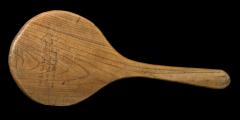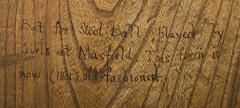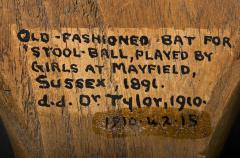ENGLAND: THE OTHER WITHIN
Analysing the English Collections at the Pitt Rivers Museum
Stoolball: a traditional English game
Zena McGreevy
formerly Pitt Rivers Museum, now Documentation Officer, Ashmolean Museum
On the Lower Gallery of the Pitt Rivers Museum is a display of objects that people all over the world have used to play ball games. Nestled within this display is a rather plain nineteenth century stoolbat [1] from county of Sussex in southern England. The bat is 47.7 centimetres in length, weighs 255.6 grams and from the appearance of the grain is carved from a single section of English hardwood. The oval-shaped hitting area is smooth and flat on both sides, apart from dents and scratches that suggest the bat was once used on a regular basis. Someone has roughly inscribed the letters FB on the base of the handle, possibly the initials of an unknown former owner. The word ‘old-fashioned’ is used in the descriptions that have been written on the stoolbat itself. ‘Old-fashioned’ was also chosen for the description entered in the Museum’s register when it was accessioned into the collection in 1910. Indeed, my curiosity in this object was first aroused because, although I am English, I had never heard of stoolball. To my surprise, a quick search on the World Wide Web revealed this game is still played in areas of England; there is even a National Stoolball Association [4].
The contemporary form of the game is described as a competitive team sport, usually played on a grass pitch with up to eleven players on each side. Teams can be either female or mixed sex, with a maximum of six men per side. According to the official rules, one side fields while the other bats. The batsperson stands in front of a wicket, which is a square board standing on a pole, while the bowler throws the ball underarm aiming to hit the wicket. The batsperson hits the ball, then scores runs by running between two wickets or sending the ball beyond the boundary. The fielders aim to get the batsperson out by either catching the ball or hitting the wicket with the ball before the batsperson makes it back to the wicket. The players still appear to use bats that are very similar in shape to the one in the Museum [5].
This description of stoolball, which includes the use of a wicket, is similar in many ways to the contemporary form of cricket. Indeed, in the printed literature and on the World Wide Web, stoolball is frequently mentioned as a possible forerunner to cricket [6]. A definite link is impossible to determine, as there is a lack of written evidence and both games have varied over time and from place to place. In the case of stoolball, when historical records exist these are usually written by those who wanted to control the game. For example, according to the National Stoolball Association:
It was about the year 1450 when Myrc, in his Instructions to Parish Priests, forbade its [stoolball] being played in churchyards.’ [7]
Similarly, a description of stoolball from the 15th Century details how:
Oliver Heywood found cause to complain on Easter Sunday 1681 that ‘as my hearers went from us through Halifax there was hundreds of people at Clark brig, in the church yard, on the green, and all along the town of young people and, others playing at Stool-ball, and other recreations, without any control’. [8]
The early historical records appear to be only observations rather than first-hand accounts of playing the game. This means it is difficult to understand, or know, the ways older forms of stoolball resembled the contemporary game. Writing in 1801, Joseph Strutt states:
Stool-ball is frequently mentioned by the writers of the three last centuries but without any proper definition of the game. [9]
Strutt then proceeds to describe a version of the game supposedly played during 1801 in parts of northern England. According to his description, people played the game by using a stool, like a wicket. A player aimed a ball at a stool, while another player stood in front of the stool attempting to deflect the ball with their hand.
Historical accounts that mention people playing the game using a stool perhaps provide an indication of why the game became known as stoolball. One of the fabled origins of stoolball I think makes a lovely story, whether accurate or not, is that the game was started by milkmaids. One version of this story relates how:
milkmaids started the game by throwing stones at their upturned stools while waiting for their shepherd husbands to return from the fields [10]
All of the historical accounts I can across about stoolball, or indeed many other games, highlight how the existence of games with official rules, played on designated area is a relatively recent phenomena. Indeed an idea of formalised ‘rules of the game’ appears to have developed in England during the Victorian period. This appears to have been an era when there was attempts to control society and within sports this manifested into the development of rules and regulations [11].
Even with the development of official rules, stoolball remained a game that was easy to play anywhere. Unlike cricket, which if played as an official sport requires a level pitch; stoolball can be played on rough ground.
The ease of play appears to be one of the reasons that stoolball has survived. I mentioned earlier, that the stoolbat was described as ‘old-fashioned’ when it entered the collections at the Museum in 1910. Indeed the game was in decline during the start of the twentieth century. Major W.W. Grantham is credited with the revival of the game during the First World War. Grantham, an army officer, introduced the game to soldiers in Brighton, who were there while recovering from their injuries. The game, which is not as vigorous as cricket, proved popular and in 1917 a public match was organised at the County Cricket Ground at Hove, near Brighton in Sussex [12].
Although a lesser known English game, stoolball survived, it has remaining popular in pockets of Sussex, the county where Grantham revived the game in the twentieth century and where the nineteenth century stoolbat at the Museum originates.
Tylor and the stoolbat
Edward Burnett Tylor, the first Professor of Anthropology at Oxford, donated the stoolbat to the Museum in 1910. There is no known information about how Tylor acquired the stoolbat and from whom. What is known is that he was very interested in the study of games [2]. He gave a number of public lectures and published papers on this subject during the late 1870s and early 1880s [3]. This established his interest in this area and he could have been offered or actively acquired the stoolbat in the course of his research.
Tylor was appointed as the first Professor of Anthropology at the University of Oxford in 1895 and donated many objects to the Pitt Rivers Museum before his death in 1917. He donated this bat to the Museum in the year he resigned as Professor of Anthropology. He viewed culture as a continuum and believed it was possible to identify the origins of culture and establish laws of cultural progress. During the late 1870s and early 1880s he became particularly interested in the study of games as a means of tracing the relationships between cultures over time and from place to place. In a meeting of the Anthropological Institute of Great Britain and Ireland held on 11 March 1879 Tylor, who was the President of the Institute, presented a paper about the geographical distribution of games. In this paper, which was published in the Institute’s Journal in 1880, he stated:
The games which have a value as proofs of connections or intercourse between the districts they are found in, must be peculiar or complex enough to bar supposition of their having sprung up independently. On close examination, the number of radically distinct games known among mankind proves to be much smaller than might have been expected. Their examination may be much simplified by arranging in groups those which appear to be variants of one game…It is clear that new varieties of games grow up freely from older forms. But it also appears that when a game is once worked into perfect fitness…it may last on with remarkable permanence…These simple amusements have held their own from thus early in the historical period, through changes that have superseded languages, dynasties and religions.’
Stoolball does appear to be a game that has had periods of decline in popularity, as records suggest it was played everywhere, then became regional then declined. Tracing the history of stoolball is problematic as it was only recorded part of an oral tradition. This highlights a problem with his analysis of games as many forms changed and were not consistent with written records, accounts were often written in restrospect or by people who had only observed the game from a distance.
Notes and further reading
[1] The Museum’s unique identification number for the bat is 1910.42.15
[2] See Gosden, Chris, Frances Larson with Alison Petch (2007). Knowing Things: Exploring the Collections at the Pitt Rivers Museum 1884 – 1945. Oxford: Oxford University Press
[3] Most of Tylor’s ideas and theories are now discredited but for an example of one of his papers about games see ‘Remarks on the Geographical Distribution of Games’ by Edward B. Tylor in The Journal of the Anthropological Institute of Great Britain and Ireland, Volume 9 (1880), pp. 23-30
[4] See http://www.stoolball.co.uk for information about the National Stoolball Association, the contemporary rules and a history of the game
[5] See http://www.mastersgames.com/cat/outdoor/stoolball.htm for pictures and details of modern stoolball equipment
[6] For mentions of a possible link between stoolball and the development of cricket see Viney, Nigel and Neil Grant (1978). An Illustrated History of Ball Games. London: Heinemann, Wikipedia (http://en.wikipedia.org/wiki/Stoolball and the National Stoolball Association (http://www.stoolball.co.uk/rules/article.php?item=4)
[7] See M.S. Russell-Groggs 'History of Sussex Stoolball' published in the July 1928 edition of the Sussex County Magazine, reproduced by the National Stoolball Association at http://www.stoolball.co.uk/history/article.php?item=119
[8] See page 42 of Malcolmson, Robert W. (1979). Popular Recreation in English Society 1700 – 1850. Cambridge: Cambridge University Press
[9] See page 101 of Strutt, Joseph with revisions by J. Charles Cox (1801). The Sports and Pastimes of the People of England. London: Methuen & Co
[10] See http://www.tradgames.org.uk/games/Bat-Ball.htm or http://www.mastersgames.com/cat/outdoor/stoolball.htm for a similar version
[11] See http://www.bbc.co.uk/history/british/victorians/sport_01.shtml
[12] For Grantham’s revival of stoolball see page 88 of Viney, Nigel and Neil Grant (1978). An Illustrated History of Ball Games and http://www.stoolball.co.uk/history-stoolball-sussex-russellgoggs.



